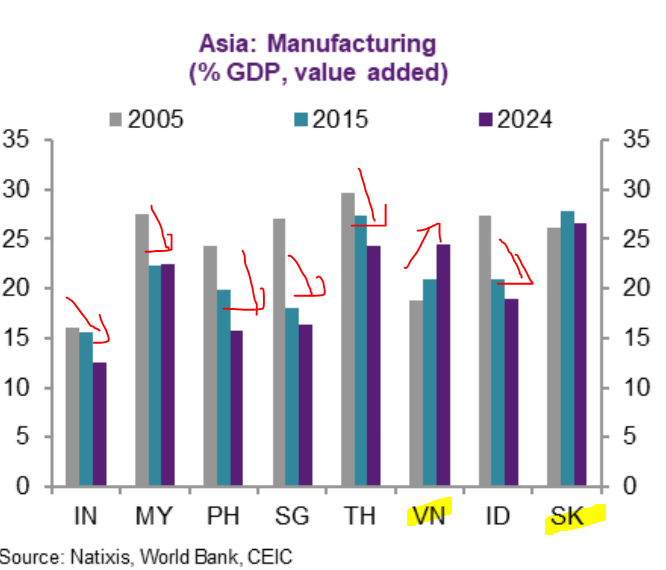Did you know that Vietnam's Q3 GDP grew 8.2%YoY and Q2 was 8%? It is one of the few countries in Asia where manufacturing share of GDP is rising even as Chinese imports flood the market. Why?
“In contrast to other countries that are stuck in political paralysis, Vietnam has moved very swiftly to secure lower tariffs and reform its economy to increase productivity and competitiveness,” @Trinhnomics , a senior economist at Natixis SA, said. “This has allowed Vietnam to emerge as a winner under Trump 2.0 despite high tariffs because it’s favored as a foreign direct investment destination for those wanting to diversify away from worsening US-China tensions.”
bloomberg.com/news/articles/…
“In contrast to other countries that are stuck in political paralysis, Vietnam has moved very swiftly to secure lower tariffs and reform its economy to increase productivity and competitiveness,” @Trinhnomics , a senior economist at Natixis SA, said. “This has allowed Vietnam to emerge as a winner under Trump 2.0 despite high tariffs because it’s favored as a foreign direct investment destination for those wanting to diversify away from worsening US-China tensions.”
bloomberg.com/news/articles/…
Look at manufacturing across Asia and what do you see? Its down for India, Malaysia, the Philippines, Thailand, Indonesia.
But not Vietnam. It's up. The fact of the matter is Vietnam faces a widening trade deficit with China but at the same time it has turned that into an overall trade surplus, which means that Vietnam value add has risen over time.
And you can see it clearly in its manufacturing share of GDP or global market share. Has been slowly steady climb.
But not Vietnam. It's up. The fact of the matter is Vietnam faces a widening trade deficit with China but at the same time it has turned that into an overall trade surplus, which means that Vietnam value add has risen over time.
And you can see it clearly in its manufacturing share of GDP or global market share. Has been slowly steady climb.

This year, in 2025 manufacturing output surged 9.92% in the first nine months of 2025 from a year earlier, with around 77% of companies surveyed by the National Statistics Office saying export orders were higher or at the same level, a sign that US buyers are shrugging off the tariff hit for now.
What is Vietnam doing right? Well, first, the most important thing is that it wants manufacturing above all else. Vietnamese people need formal jobs and by prioritizing that, Vietnam is now focusing on the next leg of development, which is how to ADD MORE VALUE.
Blink and you will miss the biggest reform story of Asia. Vietnam literally redrew its map & made one of the biggest structural reforms in decades.
What is Vietnam doing right? Well, first, the most important thing is that it wants manufacturing above all else. Vietnamese people need formal jobs and by prioritizing that, Vietnam is now focusing on the next leg of development, which is how to ADD MORE VALUE.
Blink and you will miss the biggest reform story of Asia. Vietnam literally redrew its map & made one of the biggest structural reforms in decades.
Vietnam and India had about the same share of GDP of manufacturing around 2011 but that has changed where the share of manufacturing of GDP for Vietnam has increased 10% while India's has declined about 5%. 

• • •
Missing some Tweet in this thread? You can try to
force a refresh











